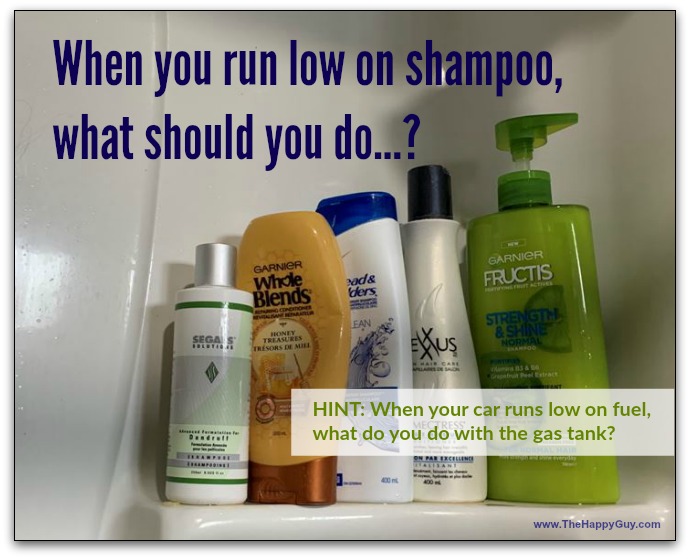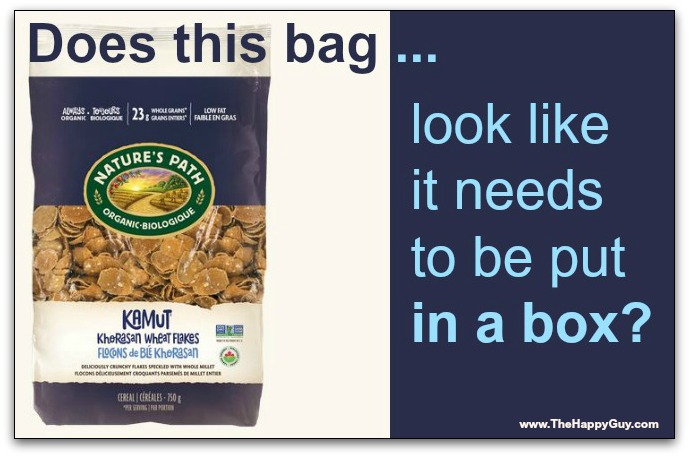Everything we buy has an impact on the environment. But some things bring us little value, even if they are “convenient”…and some of those are pure waste! So why buy them in the first place?
Sometimes we struggle between the pursuit of convenience and the need to protect the environment. But what we carelessly call “the environment” is our life support system. So, it’s important to to keep convenience in perspective.
Would you pee in the swimming pool, just because it’s convenient?
Don’t answer that.
Here is my list of top ten brainless products that should be banned. They pollute our life support system while adding little, if any, real value. When we buy them, we are peeing in the swimming pool. Let’s call them “Satan’s Little Helpers”.
Disposable shampoo bottles
Consider the life span of a shampoo bottle. You buy it, along with the shampoo inside. Eventually, you use up the shampoo. But the bottle is as good as new. So what do you do with that bottle? Best case scenario is that it gets recycled. Or it goes into the recycling stream, but ends up in a landfill. Or, worst case, it goes straight to the landfill.
But the bottle is still as good as new!
You don’t throw out your gas tank when you run low on fuel.
You don’t throw out your fridge when you run low on food.
Why throw away your shampoo bottle when you run low on shampoo?
The answer: because the stores refuse to sell you the shampoo without the bottle. Seriously, go to Walmart and try telling them you need a refill. “No thanks. I don’t need a new bottle. Just the shampoo, thank you very much.”
Good luck!
Disposable shampoo bottles should be banned. Same for conditioner bottles. And moisturizing bottles. And tooth paste tubes. And laundry detergent bottles.
In fact, all disposable containers could easily be banned, given a few years lead time for industry to re-tool. Isn’t it nuts that disposable containers exist at all?
Disposable dryer sheets
This might be less known, but there are substitutes for disposable dryer sheets, such as aluminum balls or wool dryer balls.
I use a sheet made out of fabric from PurEcoSheet that I won in a contest years ago (I wish I knew what the fabric is).
With any of these options, you don’t even have to put them in the dryer or take them out. Just keep them there.
Never think about putting in the dryer sheets.
Never make the effort to throw away the old dryer sheets.
Never pay for dryer sheets again.
And never create needless waste from dryer sheets.
Do they work? Ours do. We never have static in our clothing. Bonus, we never have unnecessary chemicals wiping off our clothes onto our bodies, either.
As an aside, when you buy disposable dryer sheets, the store will force you to buy a new box each time, too.
Wet wipes
Let’s see. We have cleansers galore at our house. You probably do, too.
We have plenty of rags, as clothes often wear out. You probably have them, too.
We are blessed to have the miracle of hot and cold running water at our house. Bet you do, too!
So why does anybody need pre-wet disposable “wipes” to clean counters, wash hands or wipe down any normal household surface? Sure, you might not want to throw a cloth full of heavy machine grease into your laundry, but all other rags are 100% washable.
Disposable wipes are nothing but garbage, wrapped in extra plastic (yes, they make you buy new plastic wrapping each time)! Don’t buy them.
Paper Towels
Like wet wipes, these are totally useless. How many trees are cut down each year to create disposable rags? How many clothes – rags in waiting – are placed in the garbage each year? ‘Nough said.
Zipper seal bags
Let me preface this by saying that zipper seal bags and similar products are not necessarily evil. Yes, they are disposable, but that’s just how they are marketed (to keep you buying more of them).
I‘ve used the same zipper seal bag – rinsed weekly and occasionally washed – for my daily cut vegetables for several months at a time.
Don’t put meat or cheese in them; that makes them hard to wash and re-use. Use them only for non-oily things and they are very handy. Unlike hard containers, they adjust to the shape and size of space available in your lunch box.
And if you are canoeing or hiking, they will keep things dry (and if you add lots of air, your passport will not only stay dry, but also float when your canoe capsizes).
Don’t hold your breath for TV ads explaining how to extend the life of your zipper seal bags. Just do it on your own. Else, they are just more disposables polluting our planet.
Plastic shopping bags
This is the du-uh item on my list. Twenty years ago, my wife and I were the only ones shopping with reusable bags at the grocery store. Now everyone does.
Well, not quite everyone. Can you believe that 500 billion plastic bags are still being given or sold for a nominal fee each year? With an average usage of 12-15 minutes each? That it takes 60 million barrels of oil to make those bags…each year? Obviously, neither the urge to avoid peeing in the communal pool, nor the “hefty” five-cent fee (where a fee is even charged at all), are dissuading shoppers from using disposable bags at grocery stores.
And how often do you see anybody bring their own bags when shopping for clothes or hardware or toys or anything else?
It’s time to ban disposable bags.
Not plastic disposable bags – all disposable bags. There’s a lot of research suggesting that paper might be as bad as plastic when life-cycle environmental damage is calculated.
Oh yes, with a ban on disposable bags people will stop forgetting to bring their bags. Occasionally, somebody will still forget, of course. At that point, they can decide to buy a new non-disposable bag at a more reasonable $2.00 price. Or they can decide to just carry out their goods.
There are options beyond disposable grocery bags. And fashion store bags. And hardware store bags. This one is just a no-brainer.
Individually wrapped packages
How many times have you bought a box of some food product, only to find that each item inside is individually wrapped, or wrapped in pairs? Cookies, crackers, snacks – there is no need for this. All that extra packaging only serves to pollute more, both by filling landfills after being used and in polluting the air when the plastic is being manufactured.
Consider the cereal box. Inside is almost always a plastic bag. Why two layers of packaging? I started buying Nature’s Path cereals because they use only one layer of packaging for many of their cereals. The cereal comes in its bag, and the branding and other information is printed on that bag – no need to put the bag inside a box.
Now Nature’s Path is working toward fully reusable packaging, along with delivery and collection of that packaging, through a service called “Loop”. We’ll be watching to see how that works out.
All packaging?
Did you notice that a lot of this is about packaging?
Although the items I list here are mostly no-brainers – packaging that is so obviously useless and polluting that it makes one’s head hurt just to look at it – almost all packaging could and should be eliminated. There are very few things we buy that actually need a disposable wrapping, whether it’s food wrapping or personal care bottles, shoe boxes or hybrid plastic-cardboard toy wrappings.
It is interesting to note that when California banned plastic grocery bags, it led to an increase in paper bags and in thicker disposable garbage bags. In other words, the plastic was bad, but the ban should have covered disposable bags of all kinds. It’s not so much the plastic, but the disposable aspect that hurts our planet.
Disposable dishes
You are probably wondering why I haven’t mentioned straws. Straws have been in the news a lot. Companies are moving from useless disposable plastic straws to useless disposable paper straws – going from worse to bad is at least in the right direction.
Or is it? Are paper straws better for the environment than plastic straws? If the research into paper versus plastic shopping bags I mentioned above is any indication, that answer is a resounding…umm…maybe?
Others have stopped serving straws altogether. Bravo!
Is this a big deal?
Based on the media attention, you would think so. But in the entertainment industry, magicians call this a “sleight of hand.” Everybody keep your eyes on the straws. See how good we are eliminating straws? Isn’t it amazing? Nobody look at the disposable cups the straws come in. Or the disposable plates and wrappings.
Let’s look at some facts:
Straws make up 4% of the pieces of plastic waste. That sounds like a lot, but straws are tiny. Altogether, they make up 0.0002% of the mass of plastic waste. Not even a drop in the bucket.
The 500 billion disposable cups they come in each year are made typically of some combination of plastic, carton and styrofoam. A reusable coffee mug (or juice, or smoothie or whatever cup) is more environmentally friendly than a disposable one after 6 to 127 uses (even factoring in the environmental impact of washing them).
We haven’t even begun to talk about disposable fast food plates, containers, cups and cutlery.
Straws are not the problem. No, your company is not amazing for eliminating straws. Your company is a HUGE polluter for pushing a non-stop torrent of pollution out your front door every day.
Of all the dishes and containers that fast food restaurants use, the easiest to eliminate tomorrow – yes, tomorrow – are beverage containers. Pass the law and BYOC (bring your own cup).
Hopefully Canada’s upcoming plastics ban will include the cups, not just the straws, and hopefully it will ban them regardless of the material – replacing plastic with paper or some other material isn’t going to fix the problem.
Drive-throughs
Drive-thrus are a double waste. This is because people using drive-throughs are not only polluting for nothing, but are often inflicting self-harm, as well. In this sedentary society, do people really need another reason to sit? They could make their coffee at home. They could walk up to the counter. Or they could sit in a vehicle with the engine running and pollute for nothing.
Drive-throughs are responsible for burning 57 million gallons of gasoline in the US alone each year. Even on the coldest Canadian winter days, there is no reason someone needs to sit in their car, running the engine, while ordering coffee or a burger or a muffin.
Or doing banking.
Or picking up a prescription.
What can you do?
Actually, there is a lot you can do. In almost all cases, you can avoid these useless polluters. I know there are people in my household who insist on using paper towels and going through the drive-through. But that doesn’t mean I have to.
And you don’t have to, either.
You have a choice.
In the long run however, it will take more than you and I to turn this boat around. Society will have to move past the disposable-for-profit (planned obsolescence) business model.
In the meantime, why would you pee in the swimming pool?

